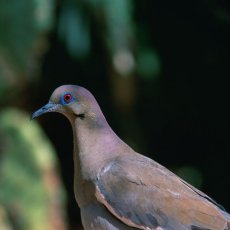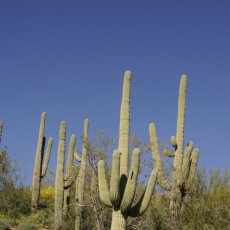|
Featured Pollinator
White-winged Doves (Zenaida asiatica) are large, semitropical birds that can be found primarily in the southernmost United States, Mexico, Central America, and the West Indies. The White-winged Dove is the only migratory bird pollinator that is also a game species. Some unique characteristics of this bird that distinguish it from other dove species are its white wing patch, its striking red eye, and its distinctive call that resembles the phrase “who cooks for you”. In the United States, the White-winged Dove has historically occurred in southern regions of Texas, New Mexico, California, and Arizona, but has within the past century expanded its range as far north as southern Colorado, and as far east as Florida. There are even records of the species in Canada in recent years. Three subspecies of White-winged Doves currently are recognized, with two of these known to reside and breed in the United States. The western subspecies inhabits areas of the southwestern U.S. and southward into west-central Mexico, and the eastern subspecies resides primarily in south Texas through eastern Mexico as well as the southeastern U.S. and the West Indies. These two subspecies are managed as separate populations. All White-winged Dove subspecies feed on wild and domestic seeds, grain and fruit, and all are important seed dispersers and pollinators.
The western subspecies of White-winged Dove is an important pollinator of the saguaro cactus (Carnegeia gigantean). This subspecies is also the main consumer of the saguaro seeds, as they rely heavily on the plant for nutrients and water during the breeding season. As a result, the breeding range of the western White-winged Dove subspecies broadly overlaps the saguaro cactus’ distribution, and its migration patterns coincide closely with the reproductive cycle of the cactus.
The diet of the eastern subspecies consists primarily of agricultural seeds and grains. Expansion of the White-winged Dove populations outside of the range of the saguaro plant is thought to be related in part to the expansion of agricultural development in the early 1900’s, as domestic grain crops produced provided a new food source and nesting habitat for the White-winged Dove. In recent years, White-winged Doves are most dense in areas of agricultural production because of the availability of food in those locations. The western subspecies of the White-winged Dove is managed by State wildlife agencies in cooperation with the U.S. Fish and Wildlife Service through a management plan developed by the Pacific Flyway Council. White-winged Doves are a popular game species and have been negatively impacted by excessive harvests in some areas. Consequently, harvest regulations were restricted in past years in an attempt to protect the population from overharvesting. Other threats to these White-winged Doves include loss of habitat from urbanization and agricultural shifts away from farming of small grains. While the western subspecies is currently showing declines, the eastern subspecies appears to be expanding its geographic range and increasing in abundance, which has afforded more recreational opportunities in recent years. Despite threats from continued increases in the human population, currently the White-winged Dove is believed to be secure throughout its range. Sources: "Migratory Pollinators." Arizona-Sonora Desert Museum. Web. 03 May 2012. Pacific Flyway Council. 2003. Pacific Flyway Management Plan for Western White-winged Doves. C/o U. S. Fish and Wildlife Service, Portland, Oregon, USA. Rabe, M. J., and T. A. Sanders. 2010. White-winged dove population status, 2010. U.S. Department of the Interior, Fish and Wildlife Service, Division of Migratory Bird Management, Washington, D.C. Schwertner, T. W., H. A. Mathewson, J. A. Roberson, M. Small and G. L. Waggerman. 2002. White-winged Dove (Zenaida asiatica), The Birds of North America Online (A. Poole, Ed.). Ithaca: Cornell Lab of Ornithology; Retrieved from the Birds of North America Online |
||||||||||||||||||||||||||||||||||
|
|
|||||||||||||||||||||||||||||||||||
| Last Updated: June 28, 2012 | |||||||||||||||||||||||||||||||||||



